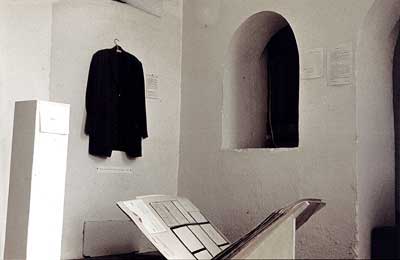
24 June – 7 July 1973 - The exhibition and events of László Beke, Miklós Erdély, György Jovánovics, Péter Legéndy, János Major, Gyula Pauer and Tamás Szentjóby.
1 July 1973 - The exhibition is made complete with the works of Miklós Erdély, György Jovánovics, János Major: Erdély Miklós-Jovánovics György-Major János: János Major’s Coat, János Major as a “living tombstone”, György Jovánovics “Wall”.

Miklós Erdély – György Jovánovics – János Major: János Major’s Coat
Text accompanying the exhibited work:
“What is Avantgardism?
Can be considered an avantgarde act that Miklós Erdély, György Jovánovics and János Major exhibited a coat?
The word avant-garde means “vanguard”.
Avant-garde artists cannot be content with the beaten track of established aesthetic rules; they rather aspire to reveal new aesthetic fields and create new aesthetic categories.
The art of the great avant-garde masters (e.g., Picasso, Mondrian, Le Corbusier) is appreciated all over the world. Avantgardism has defeated prejudice and is gaining esteem among more and more people.
In spite of this, avantgardism seems to be problematic, and the main source of the problem is the essence of avantgardism itself, its fundamental requirement: the continuous aspiration to the new.
That is to say: the avant-garde artist restricts her/himself and all other avantgardists with the creation of each new work, because no one of them can make anything similar ever again.
In this way, although it started as the art of freedom, destroying taboos, avantgardism sets more and more limits on itself with each new work of art.
I consider the coat that we exhibited together an attempt to set avantgardism free.
This work of art contains no novelty.
Exhibiting a piece of clothing is nothing new. Claes Oldenburg exhibited trousers in 1962. There is nothing new in three artists signing a single work of art. The Kukryniksy collective is a well-known example.
An objet d’art accompanied by a text that interprets the problems raised by it is not new, either, as it is the main characteristic of conceptual art (Joseph Kosuth).
And there is nothing wrong in this, either, because there is also nothing new in that there is nothing new in it.”
Translated by Adèle Eisenstein and John Bátki
A slightly different version published in Texts by Conceptual Artists from Eastern Europe: Hungary, Sources, MoMa
“This work entitled ‘János Major’s coat’, which became paradigmatic in Hungarian art […] was born during a train ride. I was travelling to Balatonboglár with Erdély and Major, and we knew that the three of us would exhibit something, but as it turned out, I was not the only one who did not know what to show. I thought I would improvise, like I had done with the small white square in plaster; Major and Erdély had not prepared either. While we were travelling, Jancsi Major took his coat off, as he was hot, and hung it up. God only knows who was the first to declare that this was a work of art... I have not heard of Erdély claiming this for himself, and Major has never said so either.”
(Interview with György Jovánovics, 1998)
7 July 1973 - Screening of the works by Árpád Ajtony, Gábor Bódy, Mihály Csákó, Gábor Dobos, Péter Donáth, Ágnes Háy, Zsuzsa Kőrösi, László Najmányi, Márk Novák, György Pór. Miklós Erdély contributes to the exhibition with his work “God is small”. His piece gets hanged below the ceiling of the chapel and is left there until it is finally closed.
